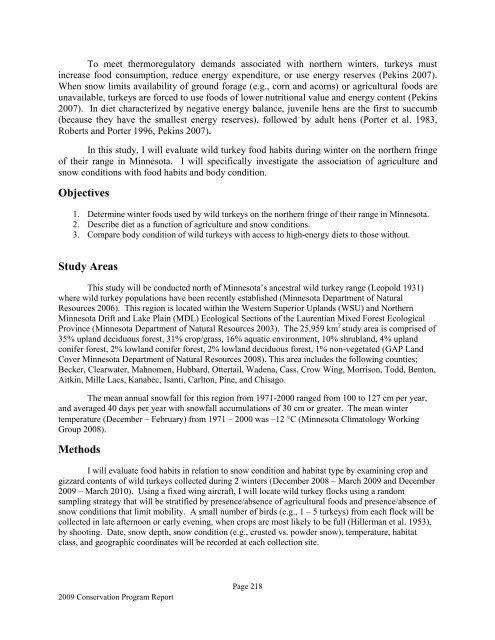camp ripley and arden hills minnesota army national guard training ...
camp ripley and arden hills minnesota army national guard training ...
camp ripley and arden hills minnesota army national guard training ...
You also want an ePaper? Increase the reach of your titles
YUMPU automatically turns print PDFs into web optimized ePapers that Google loves.
To meet thermoregulatory dem<strong>and</strong>s associated with northern winters, turkeys must<br />
increase food consumption, reduce energy expenditure, or use energy reserves (Pekins 2007).<br />
When snow limits availability of ground forage (e.g., corn <strong>and</strong> acorns) or agricultural foods are<br />
unavailable, turkeys are forced to use foods of lower nutritional value <strong>and</strong> energy content (Pekins<br />
2007). In diet characterized by negative energy balance, juvenile hens are the first to succumb<br />
(because they have the smallest energy reserves), followed by adult hens (Porter et al. 1983,<br />
Roberts <strong>and</strong> Porter 1996, Pekins 2007).<br />
In this study, I will evaluate wild turkey food habits during winter on the northern fringe<br />
of their range in Minnesota. I will specifically investigate the association of agriculture <strong>and</strong><br />
snow conditions with food habits <strong>and</strong> body condition.<br />
Objectives<br />
1. Determine winter foods used by wild turkeys on the northern fringe of their range in Minnesota.<br />
2. Describe diet as a function of agriculture <strong>and</strong> snow conditions.<br />
3. Compare body condition of wild turkeys with access to high-energy diets to those without.<br />
Study Areas<br />
This study will be conducted north of Minnesota‟s ancestral wild turkey range (Leopold 1931)<br />
where wild turkey populations have been recently established (Minnesota Department of Natural<br />
Resources 2006). This region is located within the Western Superior Upl<strong>and</strong>s (WSU) <strong>and</strong> Northern<br />
Minnesota Drift <strong>and</strong> Lake Plain (MDL) Ecological Sections of the Laurentian Mixed Forest Ecological<br />
Province (Minnesota Department of Natural Resources 2003). The 25,959 km 2 study area is comprised of<br />
35% upl<strong>and</strong> deciduous forest, 31% crop/grass, 16% aquatic environment, 10% shrubl<strong>and</strong>, 4% upl<strong>and</strong><br />
conifer forest, 2% lowl<strong>and</strong> conifer forest, 2% lowl<strong>and</strong> deciduous forest, 1% non-vegetated (GAP L<strong>and</strong><br />
Cover Minnesota Department of Natural Resources 2008). This area includes the following counties;<br />
Becker, Clearwater, Mahnomen, Hubbard, Ottertail, Wadena, Cass, Crow Wing, Morrison, Todd, Benton,<br />
Aitkin, Mille Lacs, Kanabec, Isanti, Carlton, Pine, <strong>and</strong> Chisago.<br />
The mean annual snowfall for this region from 1971-2000 ranged from 100 to 127 cm per year,<br />
<strong>and</strong> averaged 40 days per year with snowfall accumulations of 30 cm or greater. The mean winter<br />
temperature (December – February) from 1971 – 2000 was –12 C (Minnesota Climatology Working<br />
Group 2008).<br />
Methods<br />
I will evaluate food habits in relation to snow condition <strong>and</strong> habitat type by examining crop <strong>and</strong><br />
gizzard contents of wild turkeys collected during 2 winters (December 2008 – March 2009 <strong>and</strong> December<br />
2009 – March 2010). Using a fixed wing aircraft, I will locate wild turkey flocks using a r<strong>and</strong>om<br />
sampling strategy that will be stratified by presence/absence of agricultural foods <strong>and</strong> presence/absence of<br />
snow conditions that limit mobility. A small number of birds (e.g., 1 – 5 turkeys) from each flock will be<br />
collected in late afternoon or early evening, when crops are most likely to be full (Hillerman et al. 1953),<br />
by shooting. Date, snow depth, snow condition (e.g., crusted vs. powder snow), temperature, habitat<br />
class, <strong>and</strong> geographic coordinates will be recorded at each collection site.<br />
2009 Conservation Program Report<br />
Page 218
















